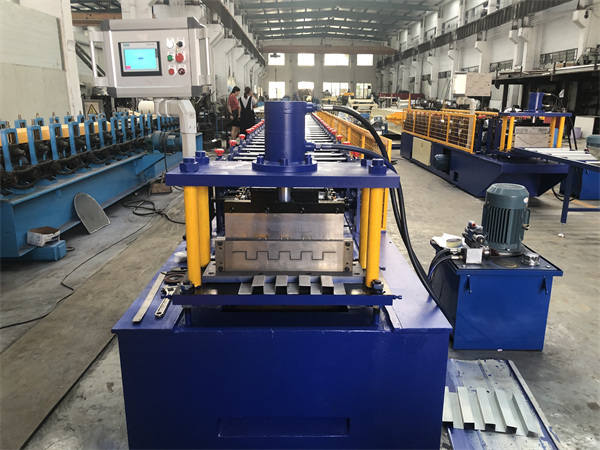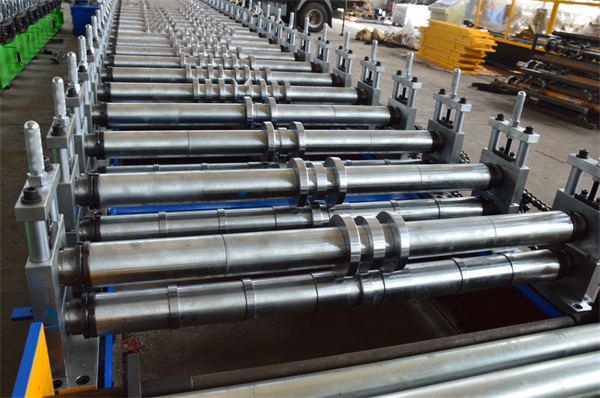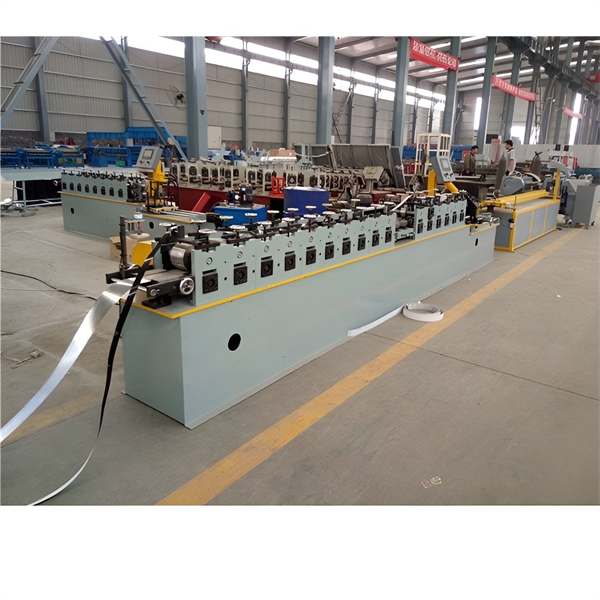Corrugated roll forming is a process used to form corrugated sheets and profiles from flat metal coils. Corrugated roll forming machines are designed specifically for high speed, high volume production of corrugated metal sheets and panels. This guide provides a detailed overview of corrugated roll forming machine types, main components, working principles, design considerations, and applications.
Overview of Corrugated Roll Forming Machines
Corrugated roll forming is a continuous bending operation in which a long strip of flat sheet metal is gradually shaped through a series of roll stands arranged in a consecutive row. The sheet passes through multiple roller dies and is formed into a corrugated profile with successive waves or ribs along its length.
Roll forming allows efficient, high-speed and high-volume production of corrugated metal sheets and panels from coils of sheet metal. It is ideal for producing roofing, wall cladding, highway barriers, drainage channels and many other applications requiring shaped, ribbed metal sheet stock.
Compared to other metal corrugating processes like manual bending or press braking, roll forming is faster and more precise with minimal tooling costs. The process can accommodate a range of materials from mild steel and stainless steel to aluminum. Thicker gauges and high strength metals are also roll formed.
Modern corrugated roll forming lines are fast, flexible and automated for cost-effective production. Semi-automatic and CNC roll formers allow quick adjustment of profiles. They can produce sheets up to 10 feet wide or more at speeds over 100 feet per minute with excellent process control.
Main Components of a Corrugated Roll Former
A typical corrugated roll forming machine consists of the following components:
| Component | Function |
|---|---|
| Uncoiler/Decoiler | Feeds the flat strip coil stock into the roll former |
| Feed table | Supports and guides the strip into the rolls |
| Forming rolls | Gradually shape the strip into corrugated profile |
| Pinch rolls | Control strip flow and back tension |
| Running table | Supports the formed profile leaving the machine |
| Cutoff shear | Cuts profiles to length |
| हाइड्रोलिक प्रणाली | Provides power for roll stations and cutoff |
| Controls | Operates and monitors the machine |
The critical forming section has a series of roll stations, each with an upper and lower roll set designed to contour the metal sequentially in small increments. The roll sets work in pairs to bend the material, with the bottom rolls usually powered and the top rolls floating.
Guide rolls, strippers, and other tools may be added to assist in the progressive bending and assist the sheet through the stations. The number and configuration of roll stands depend on the profile shape and complexity.

How Does a Corrugated Roll Forming Machine Work?
Corrugated roll forming involves continuously and gradually reshaping flat strip into a ribbed profile using a series of roller dies. Here is an overview of the forming process:
- Sheet coil stock is loaded on an uncoiler which feeds the strip through an initial straightener and into the forming section.
- The flat strip enters the first set of contoured rolls which make a small bend in the material.
- As it progresses through each stand, the strip is sequentially bent a little more by the roll contours.
- Gradually, the cumulative effect of the small bends forms the strip into corrugated profile with ribs and valleys.
- Pinch roll stands control strip flow and maintain back tension.
- The completely formed sheet exits the last stand and is supported on a runout table.
- A flying cutoff saw shears the corrugated sheets to desired lengths for use.
- The sheets can be stacked manually or automatically by a downstream conveyor system.
The key is to bend the material incrementally in steps without overstressing it. The roll contours are precision machined to shape the material progressively along the consecutive stands into finished profile.
Roll forming allows the continuous production of corrugated sheets at high speeds up to 100 ft/min or more. The process is automated for efficient coil-to-sheet manufacturing.
Types of Corrugated Roll Forming Machines
There are several configurations of corrugated roll formers to produce different profiles and sheet geometries:
| Machine Type | विवरण |
|---|---|
| Standard corrugating machine | Produces basic corrugated profiles for roofing and siding |
| Multi-profile roll former | Quickly interchangeable rolls to make different profiles |
| Wide sheet corrugator | Forms sheets over 5 ft wide for shipping containers |
| Long span corrugator | Makes extra long corrugated sheets up to 40 ft |
| Heavy gauge corrugator | Forms thicker material over 0.100 inches |
| Double layer corrugator | Creates double thickness corrugated sheets |
| Auto-feeding corrugator | With integrated uncoiler and runout table |
| CNC roll former | Fully programmable forming parameters |
- Standard corrugators – Most common machine with fixed roll sets for high volume production of standard roofing or wall profiles. Simplest design with 6-8 roll stands.
- Multi-profile roll formers – Equipped with quick change forming roll sets that can be switched out to produce different profiles on the same machine. Reduces tooling costs.
- Wide sheet corrugators – Specialized machines designed for high volume production of wide corrugated sheets for agricultural buildings, truck trailers etc. Sheet widths exceed 5 feet.
- Long span corrugators – Produce extra long corrugated panels in a single piece up to 40 ft long for industrial buildings and structures. Require additional support rolls.
- Heavy gauge corrugators – With heavy duty components to form thicker material gauges over 0.100 inch thick. Mainly used for structural roofing and siding.
- Double layer corrugators – Creates double thickness corrugated sheets by forming two sheets simultaneously and joining them together. Used for high strength panels.
- Auto-feeding corrugators – Integrates the uncoiler and runout table for automatic material flow. Reduces labor and handling.
- CNC roll formers – Fully programmable machines that can store different profiles and adjust all forming parameters through the control console. Most flexible for low to medium production runs.
Key Specifications and Design Considerations
Corrugated roll forming machines are designed and sized based on the desired sheet width, material thickness, line speed, and production volume. Here are the key specifications to consider:
Sheet Width
- Available from 1 ft to 10 ft wide or more
- Wider sheets may require support rollers
- Standard widths are 2 ft or 4 ft for roofing
द्रव्य का गाढ़ापन
- Typically 24 GA to 18 GA (0.024” – 0.048”)
- Heavier gauges require larger roll capacities
Line Speed
- Speeds up to 100 ft/min are standard
- Max speed depends on material gauge and profile complexity
उत्पादन मात्रा
- Output up to 10,000 sqft/hr
- Higher volumes require faster line speeds
Profile Shape
- Roll contours determine the rib shape and size
- More complex profiles need more roll stands
Coil Capacity
- Up to 30,000 lb coils
- Larger uncoilers for high volume production
Length Control
- Rotary shear for lengths up to 50 ft
- Flying cutoff shear for any length blanks
Automation Type
- Manual control vs. programmable PLC controls
- CNC programming for fast changeovers
When selecting a corrugated roll former, these key factors determine the machine’s size and configuration for the intended production requirements.
Applications and Uses of Corrugated Roll Forming
Corrugated roll formed panels have many uses due to their high strength, light weight, and spanning capacity. Here are some of the main applications:
Roofing and Siding
- Standard corrugated sheets for agricultural and commercial buildings
- Stronger, lighter, and faster to install vs traditional building materials
Structural Framing
- As primary purlins and girts in metal building frames
- Replaces heavier structural steel sections
Exterior Cladding
- Decorative wall covering for accenting building exteriors
- Available with special coatings and colors
Interior Walls
- Quick assembly of walled structures and partitions
- Temporary shelters, clean rooms, and containment walls
Culverts and Drainage
- Corrugated metal pipes for storm water runoff
- Trench liners and channels for infrastructure
Signage and Displays
- Decorative corrugated kickplates and facing
- Point of purchase displays and signs
Transportation
- Panels for truck trailers and containers
- Rail car and intermodal containers
Corrugated roll forming allows efficient production of ribbed metal panels ideal for roofing, siding, framing, and structural applications requiring strength, spanning ability, and fast installation.

Advantages of Corrugated Roll Forming
Compared to other metal shaping processes, corrugated roll forming has the following benefits:
- High speeds – Up to 5 times faster than brake forming
- High volumes – For mass production and long production runs
- Dimensional precision – Maintains accurate profile geometry
- Material savings – Efficient use of raw material from coil
- Labor savings – Automated process needs less workers
- Low tooling cost – Roll sets are simple and inexpensive
- Flexibility – Quick changeover to new profiles
- Material flexibility – Forms wide range of metals and gauges
- Strength – Work hardening increases sheet strength
- Lighter structures – Reduces transportation and installation costs
- Consistent quality – Repeatable forming process
By gradually reshaping the material in small increments, roll forming avoids localized overstressing or tearing common with other bending methods. The process is fast, efficient, and ideal for mass production of corrugated metal sheets and panels.
Limitations of Corrugated Roll Forming Process
Despite its advantages, corrugated roll forming has some inherent limitations to consider:
- Initial setup cost – Machines have higher initial capital cost
- Fixed profiles – Changing profiles requires roll changes
- Line length – Long machines require substantial space
- Sheet width limits – Max widths depend on machine capacity
- Sheet length limits – Depends on exit support tables
- Sheet thickness – Limited to thinner gauge metals
- Secondary operations – May need additional bending or cutting
- Profile limitations – Cannot produce complex beads or embossing
The process is most cost-effective for high volume production. Roll sets are profile specific and not easily changed. Maximum sheet widths and thicknesses are limited by the roll forming line capacity. Secondary operations may still be needed after initial corrugating.
Choosing a Corrugated Roll Forming Machine Supplier
When investing in a new corrugated roll forming system, key factors in choosing suppliers include:
| Consideration | Evaluation Criteria |
|---|---|
| Reputation | Industry experience, customer reviews |
| Roll Design | In-house engineering expertise |
| Manufacturing | Quality control and production capacity |
| Customization | Ability to accommodate special requirements |
| Inventory | Quick availability of common machine sizes |
| Support | Installation assistance and operator training |
| सेवा | Maintenance and support response time |
| Pricing | Total cost comparison of options |
- Reputation – Established companies with proven industry experience consistently producing high quality equipment. Check customer testimonials.
- Roll design – Supplier should have in-house engineering expertise to design roll tooling for different profiles and specifications.
- Manufacturing – Look for modern manufacturing with quality control testing during production. High production capacity preferred.
- Customization – Supplier should accommodate non-standard sheet requirements and provide customized roll forming solutions.
- Inventory – Quickly available common machine sizes reduces lead times. Custom machines take 1-3 months.
- Support – Installation assistance and operator training adds value.
- सेवा – Fast turnaround for technical support, maintenance, and spare parts.
- Pricing – Compare total cost of ownership over lifetime. Consider production capacity, reliability, and maintenance.
Choosing an experienced corrugated roll forming equipment manufacturer ensures high performance, quick delivery, and ongoing support.
Installation and Operation
Proper installation and operation procedures are vital for optimum performance of a corrugated roll forming system. Here are some key guidelines:
Installation
- Allow sufficient space for safe loading/unloading of coils and sheets
- Install on flat, level concrete floor to minimize vibration
- Anchor machine securely to foundation
- Connect electric power supply per specified rating
- Install all guards and safeties before operation
- Ensure proper earth grounding
Setup
- Install correct roll sets for desired profile
- Check roll settings and alignments
- Thread pilot sheet through machine gradually
- Set pinch roll tensions and shear position
- Program control parameters and test cycle
Operation
- Wear proper PPE – safety glasses, gloves, steel-toed boots
- Ensure only trained workers operate equipment
- Follow manufacturer’s operating manual
- Maintain steady strip flow and tension
- Monitor for strip tracking and vibration
- Conduct trial runs before production
- Gradually increase speeds during break-in period
- Ensure adequate lubrication during running
- Exercise caution around rotating parts and roll openings
- Keep shear area clear when cutting sheets
- Stack finished sheets carefully or convey downstream
Proper installation, setup, and running procedures will maximize corrugator performance and safety. Personnel should be fully trained to avoid mistakes leading to stand crashes. Consult the manufacturer’s guidelines for specific operational instructions.
Maintenance and Troubleshooting
A comprehensive maintenance program is essential to minimize downtime and ensure consistent quality for a corrugated roll forming line.
Preventive Maintenance
- Daily cleanup and inspection
- Check roll alignments and strip tracking
- Ensure proper lubrication on all moving parts
- Tighten any loose fasteners
- Test hydraulic system for leaks
- Inspect welds and structural connections
- Verify electrical connections are tight
Breakdown Maintenance
- Diagnose and fix problems immediately to minimize downtime
- Consult troubleshooting guides to identify issues
- Fix roll crashes or misalignment before major damage
- Replace worn roll bearings/seals promptly
- Repair leaks in hydraulics and reforming oil systems
- Address loose or worn machine components
- Update obsolete electronic components and controls
Overhauls
- Schedule periodic major overhauls for longer service life
- Regrind forming rolls to original precision contours
- Replace hydraulic pumps, motors and cylinders
- Upgrade control system and electrical parts
Proactive maintenance and quick repairs reduce unplanned outages. Partnering with the OEM can provide valuable troubleshooting expertise and parts inventory access.

सामान्य प्रश्न
Q: What sheet metal thicknesses can be roll formed?
A: Standard corrugated roll formers can form sheet thicknesses from 24 gauge to 16 gauge (0.024” – 0.060”). Heavier gauge machines are available for thicknesses exceeding 0.100”.
Q: What is the maximum sheet width for corrugated roll forming?
A: Most standard roofing corrugators accommodate sheet widths up to 5 feet. Wider corrugating machines can produce sheets over 10 feet wide for siding panels.
Q: How long are the corrugated sheets produced?
A: Sheet length is set by the flying cutoff shear and runout table size. Typical lengths up to 30 feet are standard. Long span corrugators can make sheets over 40 feet long.
Q: What types of metals can be roll formed into corrugated sheets?
A: Corrugated roll forming works for low carbon steel, stainless steel, aluminum and copper alloys. Pre-painted and galvanized coils are also formed to produce finished sheets.
Q: What determines the profile shape and rib dimensions?
A: The contour profile machined on the rolls determines the exact rib shape, height, pitch, and dimensions formed on the sheet. Rolls are profile specific.
Q: How long does it take to changeover to a new profile?
A: On manual machines, roll changeover takes 2-4 hours. On CNC machines with quick change roll sets, profile change can be done in under one hour.
